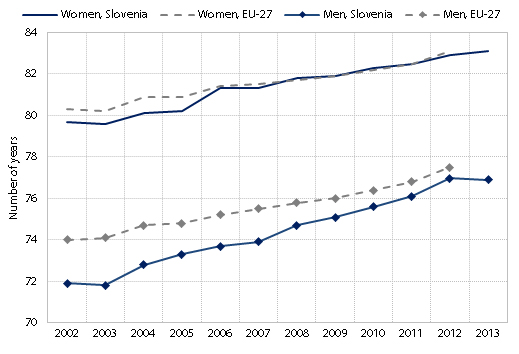SOCIAL WELL-BEING - Health
The indicator Life expectancy at birth shows the average number of years that a new-born is expected to live if from the year of observation on the age-specific mortality rates remain the same. The indicator is important for well-being, since a population with high life expectancy can be considered to be healthier. Growth of the indicator has a positive impact on well-being.
Figure: Life expectancy at birth by sex, Slovenia and the EU, 2002–2013 (number of years)

Source of data: SURS, Eurostat
Life expectancy at birth in Slovenia is growing; slightly faster for men than for women. Women born in Slovenia in 2013 can expect to live 83.1 years and men 76.9 years. Women born in 2013 can expect to live 1.8 years more than women born in 2007, while in the 2007–2013 period life expectancy for men increased by three years. The difference between life expectancy in Slovenia and the EU is getting smaller; in 2012, it was 0.2 years lower in Slovenia than in the EU for women and 0.5 years lower for men.
Results of supplementary indicators show:
In 2012, the number of healthy life years (disability-free life) at birth by sex in Slovenia was 55.6 years for women and 56.5 years for men and declined sharply after 2009 to a level well below the EU average. In 2013, both men and women in Slovenia could expect around eight healthy life years fewer on average than in the EU overall. In 2009, the difference between Slovenia and the EU was much smaller*.
Potential years of life lost up to 70 years of age show years on average lost due to premature death. In Slovenia on average around 20% fewer years are lost than in the EU overall. For women the number of years lost is over 2,400 per 100,000 population and for men almost 5,200 per 100,000 population.
In recent years cancer mortality (age-standardised rate) in Slovenia has been decreasing almost as rapidly as in the EU; however, it is still more than 16% above the EU average. In Slovenia it is almost 200 deaths due to cancer per 100,000 population (in 2013), while the EU average is almost 170 deaths per 100,000 population (in 2010).
In the past decade suicide mortality (age-standardised rate) in Slovenia has dropped significantly (from 27.1 per 100,000 population in 2000 to 18.1 per 100,000 population in 2013), but it is still much higher than the EU average (10.2 per 100,000 population). In the past ten years the gap between Slovenia and the EU has narrowed (by about 40%), but after several years of decline suicide mortality started to grow again in 2012.
The share of overweight children in Slovenia has been increasing for the past ten years. In 2002, almost 13% of children in Slovenia were overweight; in 2010 the share was 18%. In the same comparison the share of overweight children in the EU overall increased much less (from 11% to 13.5%).
In the past seven years the share of regular smokers in Slovenia decreased from 22.0% in 2002 to 19.1% in 2011. Similarly, the share of regular smokers has been decreasing in the EU, but the share of regular smokers in the EU is on average lower than in Slovenia.
Data on unmet needs for medical examination due to financial difficulties, waiting period or remoteness of health care services show that less than 1% of people in Slovenia do not use health care services due to the mentioned reasons. The share does not depend on household income. In the EU the share is almost 7%; in the lowest income quintile over 10%.
The share of persons in Slovenia aged 65+ who reported long-standing limitations in usual activities due to health problem for at least six months because of health problems increased significantly after 2009* (2013: 59.4%) and is higher than the EU average (55%).
* The reason for the decline is probably purely technical (a small change in the survey questionnaire after 2009).
